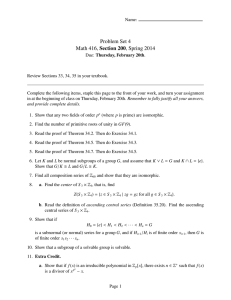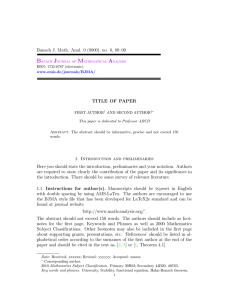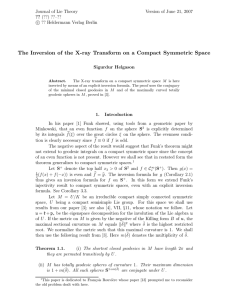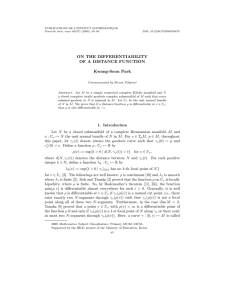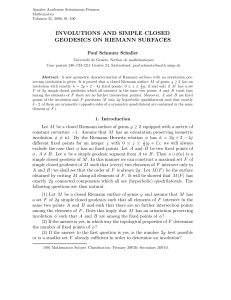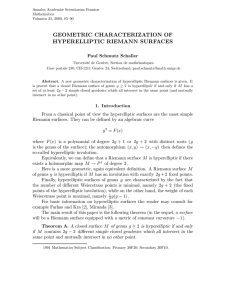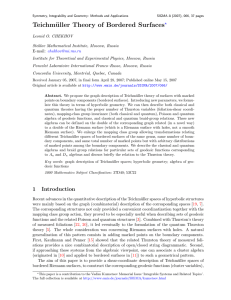BOOK REVIEWS University Press (Annals of Mathematics Studies, No. 78) 1973,
advertisement
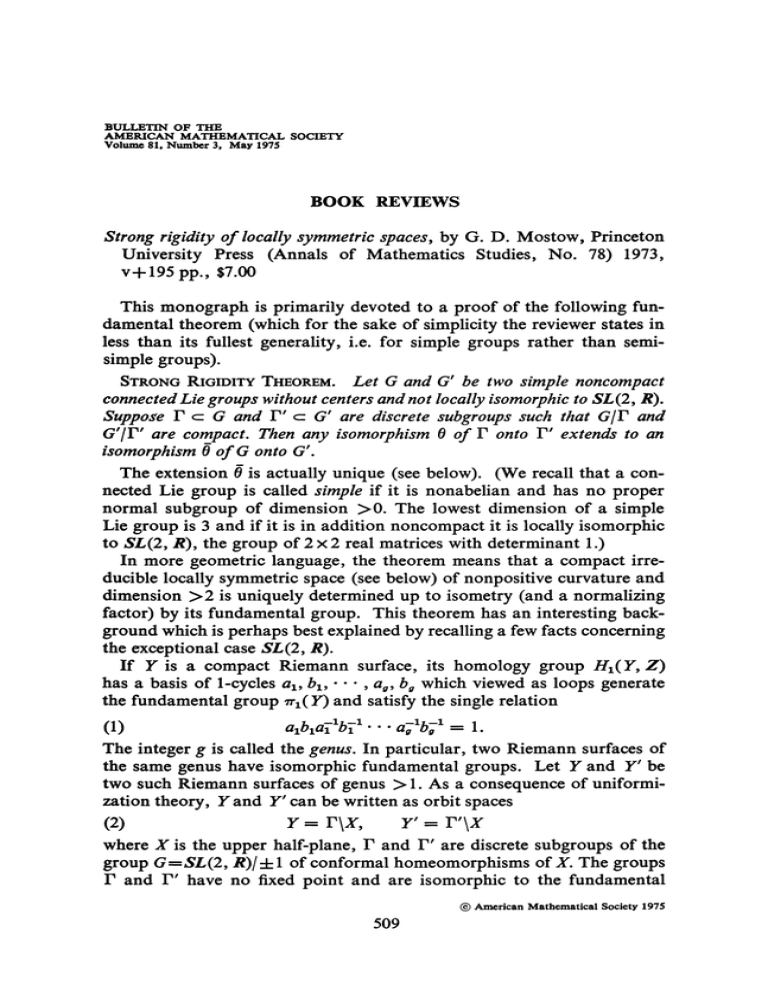
BULLETIN OF THE AMERICAN MATHEMATICAL SOCIETY Volume 81. Number 3, May 1975 BOOK REVIEWS Strong rigidity of locally symmetric spaces, by G. D. Mostow, Princeton University Press (Annals of Mathematics Studies, No. 78) 1973, v+195pp., $7.00 This monograph is primarily devoted to a proof of the following fundamental theorem (which for the sake of simplicity the reviewer states in less than its fullest generality, i.e. for simple groups rather than semisimple groups). STRONG RIGIDITY THEOREM. Let G and G' be two simple noncompact connected Lie groups without centers and not locally isomorphic to SL(29 R). Suppose Y c: G and Y' c: G' are discrete subgroups such that G\Y and G'jY' are compact. Then any isomorphism OofY onto Y' extends to an isomorphism 6 of G onto G'. The extension 6 is actually unique (see below). (We recall that a connected Lie group is called simple if it is nonabelian and has no proper normal subgroup of dimension >0. The lowest dimension of a simple Lie group is 3 and if it is in addition noncompact it is locally isomorphic to SL(2, R)9 the group of 2 x 2 real matrices with determinant 1.) In more geometric language, the theorem means that a compact irreducible locally symmetric space (see below) of nonpositive curvature and dimension > 2 is uniquely determined up to isometry (and a normalizing factor) by its fundamental group. This theorem has an interesting background which is perhaps best explained by recalling a few facts concerning the exceptional case SL(29 R). If F is a compact Riemann surface, its homology group HX(Y9Z) has a basis of 1-cycles al9bl9- • • 9ag9bg which viewed as loops generate the fundamental group ^ ( 7 ) and satisfy the single relation (1) ajt^bf1 • • • afb? = 1. The integer g is called the genus. In particular, two Riemann surfaces of the same genus have isomorphic fundamental groups. Let Y and Y' be two such Riemann surfaces of genus > 1. As a consequence of uniformization theory, Zand Y' can be written as orbit spaces (2) Y = T\X9 r = T'\X where X is the upper half-plane, Y and Y' are discrete subgroups of the group G=SL(29 R)l±l of conformai homeomorphisms of X. The groups r and Y' have no fixed point and are isomorphic to the fundamental © American Mathematical Society 1975 509 510 BOOK REVIEWS [May groups of Y and Y', respectively. From this follows readily that Y and Y' are conformally equivalent if and only if V and V' are conjugate inG. According to Riemann's problem of moduli, the set of conformai equivalence classes of compact Riemann surfaces of a given genus g> 1 is a "space" of dimension 6g—6. This means that the group V can be deformed continuously according to a (6#—6)-dimensional parameter a such that the deformed groups Ta are nonconjugate in G and make F^Z compact. The description above of the fundamental group ^ ( F ^ r explains 6g—6 in a well-known fashion: Each of the 2g generators lies in the three-dimensional group G; subtraction of three parameters determined by (1) and three more coming from conjugacy under G gives the number 3 • 2g—3-3=6#-6. In the introduction, Mostow describes the work of Selberg, CalabiVesentini, Calabi and Weil (1960-1962) which showed that this type of deformation is not possible for noncompact simple Lie groups G of dimension >3. In fact, for such a G, any discrete cocompact subgroup T is locally rigid, that is it cannot be continuously deformed except trivially, i.e. by means of inner automorphisms of G. (T cocompact means GjY compact.) As Mostow explains in the introduction his work was prompted by a search for a geometric explanation of the above local rigidity of T in terms of the boundary of the symmetric space associated with G. His strong rigidity theorem not only proves that isomorphic subgroups T and T' are necessarily conjugate under an automorphism of G, but also that all automorphisms of T are induced by automorphisms of G; the latter being mostly inner automorphisms, this implies considerable limitations on T as an abstract group for it to be imbeddable in G as a discrete cocompact subgroup. We shall now give a rough description of the main steps in the author's remarkable proof. Let KczG and K'<^G' be maximal compact subgroups (unique up to conjugacy) and X=G/K9 X'^G'jK' the associated symmetric spaces. (É. Cartan proved that G has an involutive automorphism with fixed point set K\ this induces an involution on X with an arbitrarily prescribed point as a uniquefixedpoint; hence the term "symmetric".) In the case when X and X' have constant curvature the author proved the theorem in a 1968 paper using the concept of a quasi-conformal mapping; for the general case he introduces the key notion of a pseudo-isometry for a map q> from a metric space M to a. metric space M': given constants &_1, 6 = 0 , <p is a (k, 6)-pseudo-isometry if (3) d(<p(x), <p(y)) = kd(x9 y)9 for x9yeM; (4) d(cp(x),<p(y))^k-id(x9y)9 1975] BOOK REVIEWS 511 for x,yeM such that d(x,y)^b, d denoting distance. This seemingly unwieldy notion turns out to be most effective. The group V being necessarily finitely generated it has, by a lemma of Selberg, a torsion-free normal subgroup of finite index. This can be used to reduce the theorem to the case when F and T' are torsion-free (as will now be assumed). (i) There exists a pseudo-isometry <p:X-+X' compatible with 0. To indicate the construction note that the assumption on Y implies that it has no fixed points so Y\X is a compact differentiable manifold. By triangulation Y\X becomes a finite simplicial complex. By standard topology there exists a continuous map <p:X->X' compatible with 0 such that the induced map y:Y\X-+Y'\X' is simplicial; in particular, (p satisfies a Lipschitz condition which readily implies that <p satisfies (3). The verification of (4) requires additional geometric information about X, namely that each y G Y leaves a geodesic Ya X stable and that such a geodesic satisfies inf d(x, yx) = inf d(y, yy). xeX ye Y This identity, used on X', implies quite simply that if 2r' is the length of the shortest geodesies in Y'\X' then the natural map IT':X'-+Y'\X' is injective on each ball of radius <r'. This suffices for the verification of (4). (ii) Let cp:X-+X' be a continuous map satisfying (4). Then dimX'^ dim X. If the equality sign holds then <p is surjective. This is first proved for Euclidean spaces by topological methods. The analog for X and X' then results from the fact that the exponential mapping at a point p e X is a length-increasing map of the tangent space Xp onto X. Combining these two steps (i), (ii) we see that Zand X' have the same dimension. By a flat in X is meant a flat totally geodesic submanifold of X. The rank of Zis by definition the maximum dimension offlatsin X. The author now gives a simple proof of the known fact that the rank of X is also the highest rank among the abelian subgroups of I\ In particular, X and X' have the same rank r, a fact that had been pointed out by J. Wolf. In §6 the author undertakes a detailed investigation of the orthogonal projection of X onto a flat Fa X. This is used in §7 to give a precise estimate of the length of the intersection of a geodesic with a tubular neighborhood of another geodesic. But the high point of §7 is a description of the intersection of an r-flat Fin X with a tubular neighborhood of another flat F0 (it is approximately a splice as defined below). These geometric investigations (which do not involve Y) are fundamental for the remaining steps in the proof. 512 [May BOOK REVIEWS (iii) Let SF and !F\ respectively, denote the spaces ofr-flats in X and in X\ There exists a constant v with the following property: for each Fe& there exists a unique F' e y such that (hd denoting Hausdorff distancé) hd((p(F),F')<v. The mapping <p:F-+F' is a homeomorphism of 3P onto &'. We recall that the Hausdorff distance of two subsets A, B of a metric space is the infimum of the numbers r such that A lies in an r-tube around B and B in an r-tube around A. Step (iii) is now refined by means of the notion of a splice. Let F^F^elF and x eF. Then F0 nx F denotes the union of all geodesic rays in F having origin x and contained in some tubular neighborhood of F0. Such a set is called a splice. On the other hand the Euclidean space F is divided up into (Weyl) chambers by means of certain hyperplanes through the origin x; each splice is a union of chambers and chamber walls. The maximal boundary X0 of X (in the sense of Furstenberg, Karpelevic and Satake) can be defined as the set of equivalence classes of chambers in X, two subsets of X being called equivalent if they have afiniteHausdorff distance. (iv) For any F9F0elF and any p eF,p' e y(F) (5) hd(<p(F0 n9 F), <p(F0) r v m < oo. Consequently, if C(X) denotes the set of equivalence classes of splices in X, we have a bijection (6) 9*:C(X)-+C(xy But since the chambers can be characterized among the splices, (6) implies that cp induces a bijection (p0 of X0 into X'Q. That <p0 is a homeomorphism of X0 onto XQ results from the following refinement of (iii). (v) There exists a constant c>0 with the following property: for each chamber F+ in X there exists a chamber F'+ in X'such that hd(q>(F+), F+)<c. COMPLETION OF THE PROOF. Let r(G) denote the set of parabolic subgroups of G. According to a basic theorem of Tits (which the author has to extend to not necessarily algebraic groups) the group G can be, in a certain precise sense, determined by the lattice structure of T(G), provided G has no center and the rank r is >1. Let S be a geodesic ray or a chamber wall or a chamber in X. Then the set of g G G for which the sets S and gS are equivalent is a parabolic subgroup F(S) and the mapping S-+P(S) induces a bijection of a subset of C(X) onto T(G). The bijection cp* in (6) therefore furnishes the desired isomorphism of G onto G' (provided r>l). If the rank r is one, a different argument is needed. In this case it is known by classification that the space X is a hyperbolic space H% where 1975] BOOK REVIEWS 513 JSTis either the real numbers, the complex numbers, the quaternions or the Cayley numbers (with n=2). Mostow modifies the known models of these spaces in a very efficient manner so that they are in all cases the unit ball in Kn with a unified formula for the metric (p. 144). This innovation is particularly welcome and from that point on the classification is virtually unnecessary. In a natural way the author generalizes the concept of a quasiconformal mapping to a iT-quasiconformal mapping over K and proves by deep geometric analysis that the boundary map cv X0-+XÓ is not only a homeomorphism (cf. (iv)) but is iT-quasiconformal. (Here X0 and XQ are spheres). Except for the case dim X0=l (G=5X(2, R)l±l) the author deduces a smoothness property for q>0, which quickly implies X=X', G=G'. Using an ergodicity property of the group of transvections along a geodesic, acting on GjT, the author proves with great virtuosity that <p0 sends JT-spheres into JT-spheres and finally that cp0 is induced by an automorphism of G, extending 0, completing the proof. The proof applies for the most part also to the case when the compactness assumption about GjT is replaced by the weaker hypothesis of finite G-invariant measure (r is then called a lattice). In fact, only in (i) is the compactness essential. Combining this work with subsequent contributions of Margulis (for r > l ) and Prasad (for r = l , sharpening an earlier result of Garland-Ragunathan) the strong rigidity is in fact established for lattices. (Local rigidity, at least for arithmetic lattices T, was known before as a result of work of Borel, Garland and Ragunathan.) It seems clear that the geometric methods introduced in this work will influence further studies of symmetric spaces, far beyond rigidity questions. Among the author's simpler results of general interest we quote the following: the infimum of the displacement d(x, gx) effected by an isometry g of the symmetric space X is [4 Tr(log pol g)2]1/2 (pol = polar part). The infimum is attained if and only if g is semisimple; the points in X of minimum displacement form a totally geodesic subspace on which the centralizer of g in G operates transitively. For results of this type Mostow uses his old method of imbedding l a s a totally geodesic subspace in the space of positive definite matrices; this results in direct elementary proofs requiring hardly any tools from differential geometry. In various other ways the author has succeeded in making the exposition relatively selfcontained and, happily, free of "exercises" as a substitute for omitted proofs, resulting in an up-to-date treatment of the rigidity question which is easily accessible to anyone with minimum background in the theory of semisimple Lie groups and symmetric spaces. 514 [May BOOK REVIEWS (Communicated by the author) Should read lï-rank G ERRATA p- 32 line 3 p- 49 line 4 p- 69 line 3 p- 134 line 10 p- 136 line —7 p- 142 line 2 p- 187 line 5 p. 187 line 6 T\X Sp(l9n)ISp(l)xSp(n) projective space P% as cyclic JT-subspaces of Kn+1, represent them as hermitian projections onto cyclic iT-subspaces of Kn+1 with respect to HI ' - • 6 extends to a unique analytic isomorphism • • • • • • from Theorem 18.1, Corollary 23.6, and Lemma 8.6. SlGURDUR HELGASON Complete normed algebras, by F. F. Bonsall and J. Duncan, Ergebnisse der Mathematik und ihrer Grenzgebiete, Band 80, Springer-Verlag, New York, Heidelberg, Berlin 1973, x+301 pp. $26.20 It was in 1939 that I. M. Gelfand [10] announced the results of his pioneering investigations of Normed Rings, thereby launching a new field of mathematical research which continues 35 years later in a state of vigorous development. For Gelfand, a normed ring was in fact a complete normed algebra; i.e., an algebra for which the underlying vector space is a (usually complex) Banach space and multiplication is continuous with respect to the given Banach space norm. Continuity of multiplication is usually provided by imposing the multiplicative inequality, ||xy||^ ||x|| ||ƒ ||, on the norm. For obvious reasons, these algebras have come to be known as "Banach algebras", a term which is now ratherfirmlyestablished in the literature.1 Such algebras were in fact studied earlier by M. Nagumo [18] and K. Yosida [26] who called them "metric rings". Also, as might be expected, some of the concepts arising in the earlier study of operators on a Banach space, as well as the study of certain 1 The authors remark (p. 4) that they would have preferred the term "Gelfand algebra" for a complete normed algebra. Although the reviewer had much to do with establishing the term "Banach algebra" and has a strong preference for terminology that suggests the nature of the indicated object, he agrees that "Gelfand algebra" would have been a most appropriate choice. Since this book will no doubt be widely accepted, the authors, given the courage of their convictions, probably could have effected the change.





